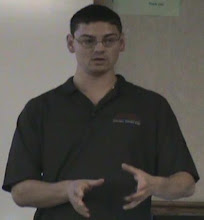Tuesday, December 21, 2010
Can override the RNG in Cove's local simulation
I checked in a change to Cove's local simulation yesterday that allows for the random number generator to be overridden in classes derived from the quantum register. This was inspired by some discussions I've been having with Noon Silk. My intention for this is to allow users to swap out the random number generator if desired, not to give the simulation predictable behavior for testing and such.
Thursday, December 16, 2010
Building on top of Cove
Noon Silk is building on top of Cove (my quantum computing framework). Specifically you should check out his "qutils" project here and his blog post about it here. For starters it can generate Cove code from qasm files, which is what I used to create the circuit diagrams in my dissertation.
Here's an example of an input:

Transformed to Cove as the output:

Nice to be this seeing done. At one point I had considered building a tool to allow you to create a circuit diagram in a GUI and generate code from it, but it was low on my list and something I never got around to doing. Nice to see this being done, I see it as an excellent tool- especially for students of quantum computer programming.
Here's an example of an input:

Transformed to Cove as the output:

Nice to be this seeing done. At one point I had considered building a tool to allow you to create a circuit diagram in a GUI and generate code from it, but it was low on my list and something I never got around to doing. Nice to see this being done, I see it as an excellent tool- especially for students of quantum computer programming.
Changes to local simulation implementation of Cove
I've gone through and made some changes to the local simulation of Cove. (Cove is the framework for quantum computing I've developed.) Cove separates the what needs to be provided as interfaces from the how, which is provided by implementations to those interfaces. Currently I've supplied a prototype implementation which I refer to as the local simulation implementation. This simulates a quantum computer on the local PC. This is very much a prototype, with some methods not implemented and plenty of room to improve the efficiency of the simulation, the later which has never been a goal of mine.
The change I've made to the local simulation is that the methods are now virtual. I originally intended implementations to be swapped out from one another and not built on each other. So the change to virtual methods opens up a cleaner derived implementation. There may be other changes I make to further promote building implementations on top of each other. These changes were inspired by some discussions I've been having with Noon Silk.
The change I've made to the local simulation is that the methods are now virtual. I originally intended implementations to be swapped out from one another and not built on each other. So the change to virtual methods opens up a cleaner derived implementation. There may be other changes I make to further promote building implementations on top of each other. These changes were inspired by some discussions I've been having with Noon Silk.
Tuesday, December 14, 2010
Nielsen and Chuang 10th Anniversary Edition
Nielsen and Chuang's Quantum Computation and Quantum Information is considered to be a classic in the field. (I named it one of my top quantum computing books last year.) They're coming out with a 10th anniversary addition. You can preorder it here on Amazon, it is available at the end of January 2011. The new addition is hardcover and about what I paid for my paperback version. I recommend reading Nielsen's comments before you rush out and buy it if you already own a copy.
U of Georgia to get 2 million for quantum computing
Looks like more money towards quantum computing. The University of Georgia is getting 2 million for quantum computing.
Monday, December 13, 2010
TQC 2011
For those who have not seen the announcement yet: The 6th Conference on Theory of Quantum Computation, Communication, and Cryptography.
Thursday, December 9, 2010
A Flowchart Language for Quantum Programming
From IEEE: A Flowchart Language for Quantum Programming by Feng and Ming. Unfortunately you have to be a member to read it. Selinger did work on a quantum flow chart language back in 2004 [1], so I wonderful how unique this is? I always though visual examples of quantum programming languages portrayed quite a bit, so here's an example of Selinger's "Quantum Flow Charts" or QFC:

References
[1] P. Selinger, "Towards a Quantum Programming Language," Mathematical Structures in Computer Science vol. 14, pp. 527-586, Aug. 2004 2004.

References
[1] P. Selinger, "Towards a Quantum Programming Language," Mathematical Structures in Computer Science vol. 14, pp. 527-586, Aug. 2004 2004.
Subscribe to:
Comments (Atom)
